Cathodoluminescence (CL) Characteristics of Quartz from Different Metamorphic Rocks within the Kaoko Belt (Namibia)
Abstract
:1. Introduction
2. Geological Background and Sample Material
- Garnet zone: 500 ± 30 °C, 9 ± 1 kbar
- Staurolite zone: 580 ± 30 °C, 7–8 kbar
- Kyanite zone: 590 ± 30 °C, 6.5–8 kbar
- Kyanite-sillimanite-muscovite zone (ky-sill-mu zone): 650 ± 20 °C, 9 ± 1.5 kbar
- Sillimanite-K-feldspar zone (sill-ksp zone): 690 ± 40 °C, 4.5 ± 1 kbar
- Garnet-cordierite-sillimanite-K-feldspar zone (grt-cd-sill-ksp zone): 750 ± 30 °C, 4.0–5.5 kbar
3. Analytical Methods
4. Results
4.1. Garnet Zone
4.2. Staurolite Zone
4.3. Kyanite Zone
4.4. Kyanite-Sillimanite-Muscovite Zone
4.5. Garnet-Cordierite-Sillimanite-K-Feldspar Zone
4.6. Summary of Results
5. Discussion
5.1. CL Colors and Emission Bands
5.2. CL Characteristics of the Metamorphic Quartz
6. Conclusions
Author Contributions
Acknowledgments
Conflicts of Interest
References
- Götze, J. Chemistry, textures and physical properties of quartz—geological interpretation and technical application. Miner. Mag. 2009, 73, 645–671. [Google Scholar] [CrossRef]
- Götze, J.; Möckel, R. Quartz: Deposits, Mineralogy and Analytics; Springer Geology: Heidelberg, Germany; New York, NY, USA; Dordrecht, The Netherlands; London, UK, 2012; p. 360. ISBN 978-3-642-22160-6. [Google Scholar]
- Zinkernagel, U. Cathodoluminescence of quartz and its application to sandstone petrology. Contrib. Sedimentol. 1978, 8, 1–69. [Google Scholar]
- Ramseyer, K.; Baumann, J.; Matter, A.; Mullis, J. Cathodoluminescence colours of alpha-quartz. Miner. Mag. 1988, 52, 669–677. [Google Scholar] [CrossRef]
- Götze, J.; Plötze, M.; Habermann, D. Cathodoluminescence (CL) of quartz: Origin, spectral characteristics and practical applications. Miner. Petrol. 2001, 71, 225–250. [Google Scholar] [CrossRef]
- Stevens-Kalceff, M.; Phillips, M.R. Cathodoluminescence microcharacterization of the defect structure of quartz. Phys. Rev. B 1995, 52, 3122–3134. [Google Scholar] [CrossRef]
- Götze, J.; Plötze, M.; Trautmann, T. Structure and luminescence characteristics of quartz from pegmatites. Am. Miner. 2005, 90, 13–21. [Google Scholar] [CrossRef]
- Stevens-Kalceff, M.A. Cathodoluminescence microcharacterization of point defects in α-quartz. Miner. Mag. 2009, 73, 585–606. [Google Scholar] [CrossRef]
- Götze, J. Application of cathodoluminescence (CL) microscopy and spectroscopy in geosciences. Microsc. Microanal. 2012, 18, 1270–1284. [Google Scholar] [CrossRef] [PubMed]
- Götte, T.; Ramseyer, K. Trace element characteristics, luminescence properties and real structure of quartz. In Quartz: Deposits, Mineralogy and Analytics; Götze, J., Möckel, R., Eds.; Springer Geology: Heidelberg, Germany; New York, NY, USA; Dordrecht, The Netherlands; London, UK, 2012; pp. 265–285. ISBN 978-3-642-22160-6. [Google Scholar]
- Götze, J.; Pan, Y.; Stevens-Kalceff, M.; Kempe, U.; Müller, A. Origin and significance of the yellow cathodoluminescence (CL) of quartz. Am. Miner. 2015, 100, 1469–1482. [Google Scholar] [CrossRef]
- Gorton, N.T.; Walker, G.; Burley, S.D. Experimental analysis of the composite blue cathodoluminescence emission in quartz. J. Lumin. 1997, 72–74, 669–671. [Google Scholar] [CrossRef]
- Siegel, G.H.; Marrone, M.J. Photoluminescence in as-drawn and irradiated silica optical fibers: An assessment of the role of nonbridging oxygen defect centers. J. Non Cryst. Solids 1981, 45, 235–247. [Google Scholar] [CrossRef]
- Matter, A.; Ramseyer, K. Cathodoluminescence microscopy as a tool for provenance studies of sandstones. In Provenance of Arenites; Zuffa, G.G.D., Ed.; Reidel Publishing Company: Dordrecht, The Netherlands, 1985; pp. 191–211. [Google Scholar]
- Owen, M.R. Application of cathodoluminescence to sandstone provenance. In Luminescence Microscopy: Quantitative and Qualitative Aspects; Barker, C.E., Kopp, O.C., Eds.; SEPM: Dallas, TX, USA, 1991; pp. 67–76. [Google Scholar]
- Seyedolali, A.; Krinsley, D.H.; Boggs, S.; O’Hara, P.F.; Dypvik, H.; Goles, G.G. Provenance interpretation of quartz by scanning electron microscope-cathodoluminescence fabric analysis. Geology 1997, 25, 787–790. [Google Scholar] [CrossRef]
- Götze, J.; Zimmerle, W. Quartz and silica as guide to provenance in sediments and sedimentary rocks. Contrib. Sediment. Petrol. 2000, 21, 1–91. [Google Scholar]
- Boggs, S., Jr.; Kwon, Y.I.; Goles, G.G.; Rusk, B.G.; Krinsley, D.; Seyedolali, A. Is quartz cathodoluminescence color a reliable provenance tool? A quantitative examination. J. Sediment. Res. 2002, 72, 408–415. [Google Scholar] [CrossRef]
- Richter, D.K.; Götte, T.; Götze, J.; Neuser, R.D. Progress in application of cathodoluminescence (CL) in sedimentary geology. Miner. Petrol. 2003, 79, 127–166. [Google Scholar] [CrossRef]
- Götte, T.; Richter, D.K. Cathodoluminescence characterization of quartz particles in mature arenites. Sedimentology 2006, 53, 1347–1359. [Google Scholar] [CrossRef]
- Augustsson, C.; Reker, A. Cathodolumenescence Spectra of Quartz as Provenance Indicators Revisited. J. Sediment. Res. SEPM 2012, 82, 559–570. [Google Scholar] [CrossRef]
- Götze, J. Classification, mineralogy and industrial potential of SiO2 minerals and rocks. In Quartz: Deposits, Mineralogy and Analytics; Götze, J., Möckel, R., Eds.; Springer Geology: Heidelberg, Germany; New York, NY, USA; Dordrecht, The Netherlands; London, UK, 2012; pp. 1–27. ISBN 978-3-642-22160-6. [Google Scholar]
- Sprunt, E.S.; Dengler, L.A.; Sloan, D. Effects of metamorphism on quartz cathodoluminescence. Geology 1978, 6, 305–308. [Google Scholar] [CrossRef]
- Owen, M.R. Sedimentary petrology and provenance of the upper Jackford sandstone (Morrowan), Ouachita Mountains, Arkansas. Ph.D. Thesis, University of Illinois, Urbana, St. Louis, MO, USA, 1984. [Google Scholar]
- Van den Kerkhof, A.M.; Kronz, A.; Simon, K.; Scherer, T. Fluid-controlled recovery in granulite as revealed by cathodoluminescence and trace element analysis (Bamble sector, Norway). Contrib. Miner. Petrol. 2004, 146, 637–652. [Google Scholar]
- Spear, F.S.; Wark, D.A. Cathodoluminescence imaging and titanium thermometry in metamorphic quartz. J. Metamorph. Geol. 2009, 27, 187–205. [Google Scholar] [CrossRef]
- Gruner, B. Metamorphoseentwicklung im Kaokogürtel, NW-Namibia: Phasenpetrologische und geothermobarometrische Untersuchungen panafrikanischer Metapelite. Ph.D. Thesis, University Würzburg, Würzburg, Germany, 2000. [Google Scholar]
- Porada, H. The Damara-Ribeira Orogen of the Pan-African-Brasiliano cycle in Namibia (South West Africa) and Brazil as interpreted in terms of continental collision. Tectonophysics 1979, 57, 237–265. [Google Scholar] [CrossRef]
- Frimmel, H.E.; Klötzli, U.S.; Siegfried, P.R. New Pb-Pb single zircon age constraints on the timing of Neoproterozoic glaciation and continental break-up in Namibia. J. Geol. 1996, 104, 459–469. [Google Scholar] [CrossRef]
- Miller, R.M. The Pan-African Damara Orogen of South West Africa/Namibia. In Evolution of the Damara Orogen; Special Publications of the Geological Society of South Africa: Johannesburg, South Africa, 1983; pp. 31–515. [Google Scholar]
- Kröner, S.; Konopásek, J.; Kröner, A.; Poller, U.; Wingate, M.W.D.; Passchier, C.W.; Hofmann, K.H. U-Pb and Pb-Pb zircon ages for metamorphic rocks in the Kaoko Belt of NW Namibia: A Palaeo- to Mesoproterozoic basement reworked during the Pan-African orogeny. S. Afr. J. Geol. 2004, 107, 455–476. [Google Scholar] [CrossRef]
- Goscombe, B. and Gray, D.R. The coastal terrane of the Kaoko Belt, Namibia: Outboard arc-terrane and tectonic significance. Precambrian Res. 2007, 155, 139–158. [Google Scholar] [CrossRef]
- Neuser, R.D.; Bruhn, F.; Götze, J.; Habermann, D.; Richter, D.K. Kathodolumineszenz: Methodik und Anwendung. Zent. Geol. Paläontologie Teil I 1995, H 1, 287–306. [Google Scholar]
- Kröner, S.; Jung, S.; Kröner, A. A ~700 Ma Sm Nd garnet whole rock age from the granulite facies Central Kaoko Zone (Namibia): Evidence for a cryptic high-grade polymetamorphic history? Lithos 2007, 97, 247–270. [Google Scholar]
- Luff, B.J.; Townsend, P.D. Cathodoluminescence of synthetic quartz. J. Phys. Condens. Matter 1990, 2, 8089–8097. [Google Scholar] [CrossRef]
- Ramseyer, K.; Mullis, J. Factors influencing short-lived cathodoluminescence of alpha-quartz. Am. Miner. 1990, 75, 791–800. [Google Scholar]
- Götze, J.; Plötze, M.; Graupner, T.; Hallbauer, D.K.; Bray, C. Trace element incorporation into quartz: A combined study by ICP-MS, electron spin resonance, cathodoluminescence, capillary ion analysis and gas chromatography. Geochim. Cosmochim. Acta 2004, 68, 3741–3759. [Google Scholar] [CrossRef]
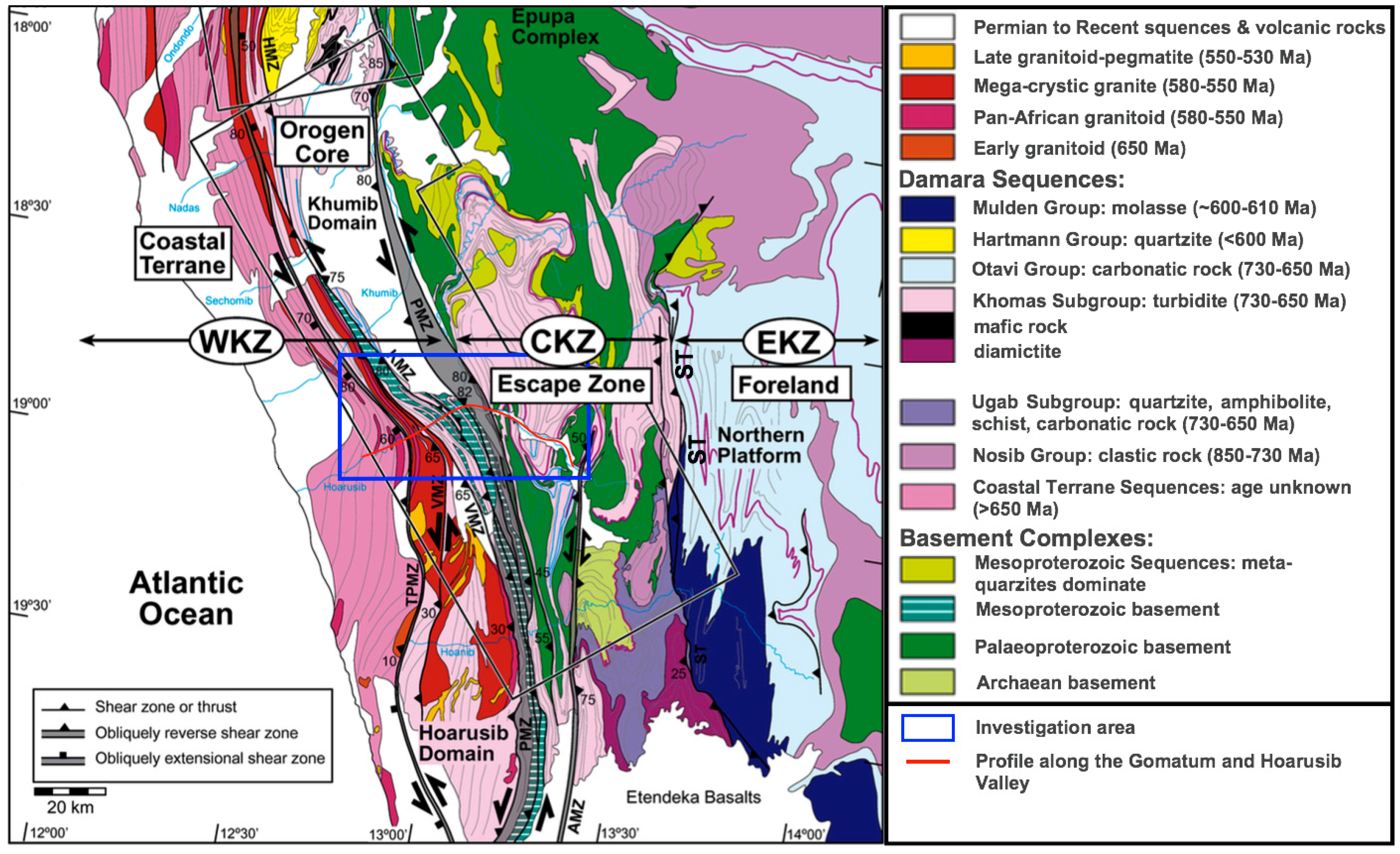
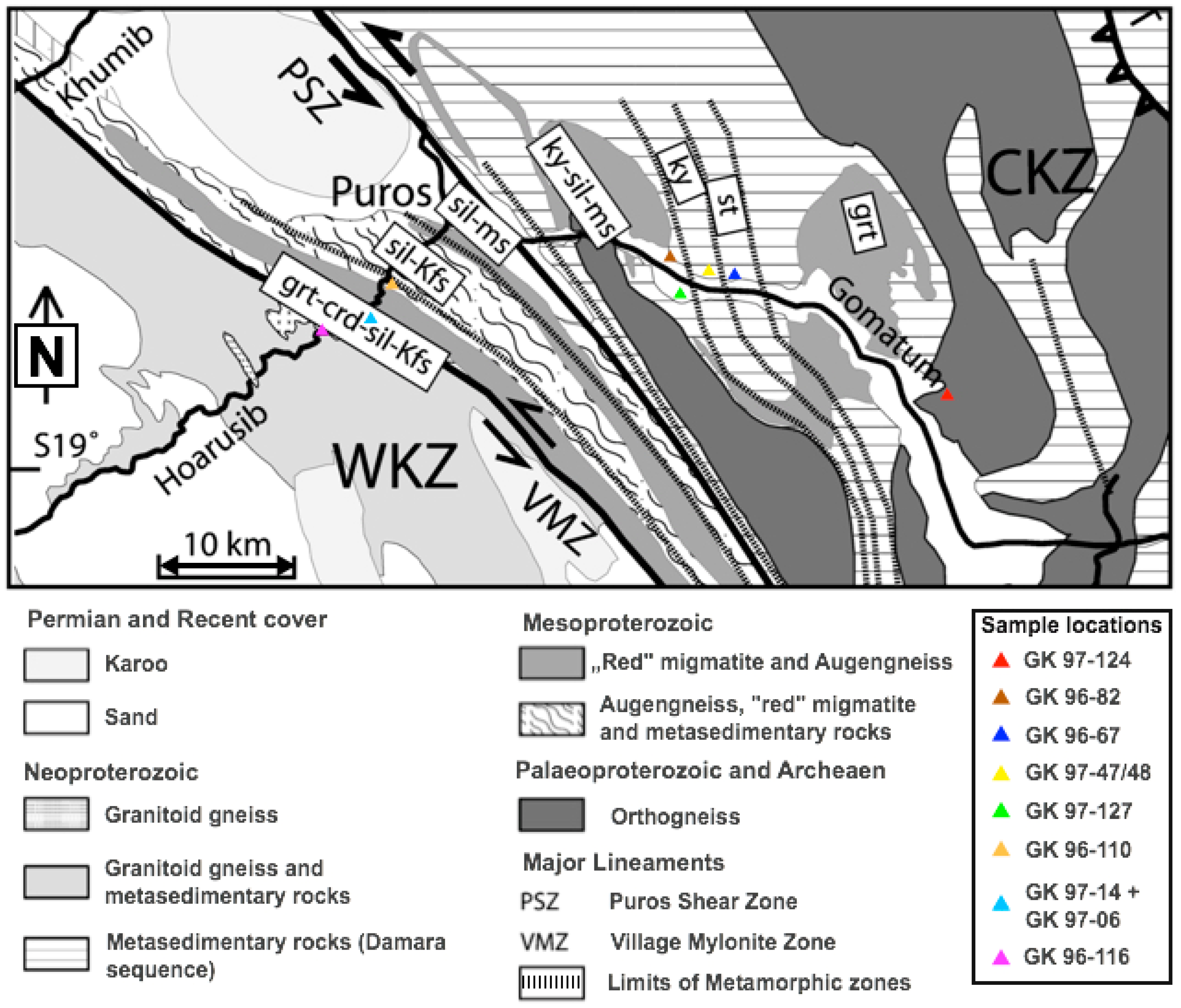
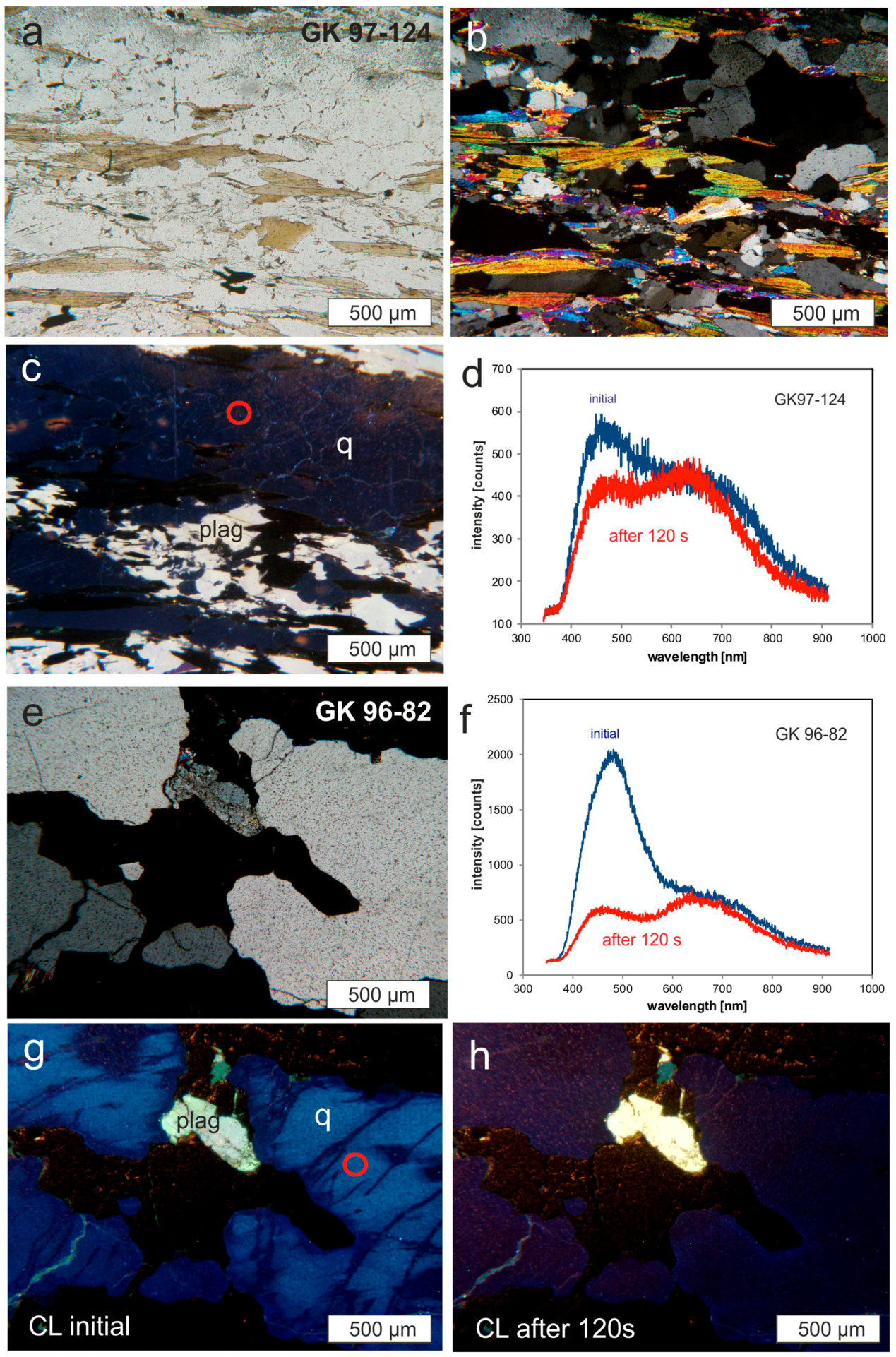
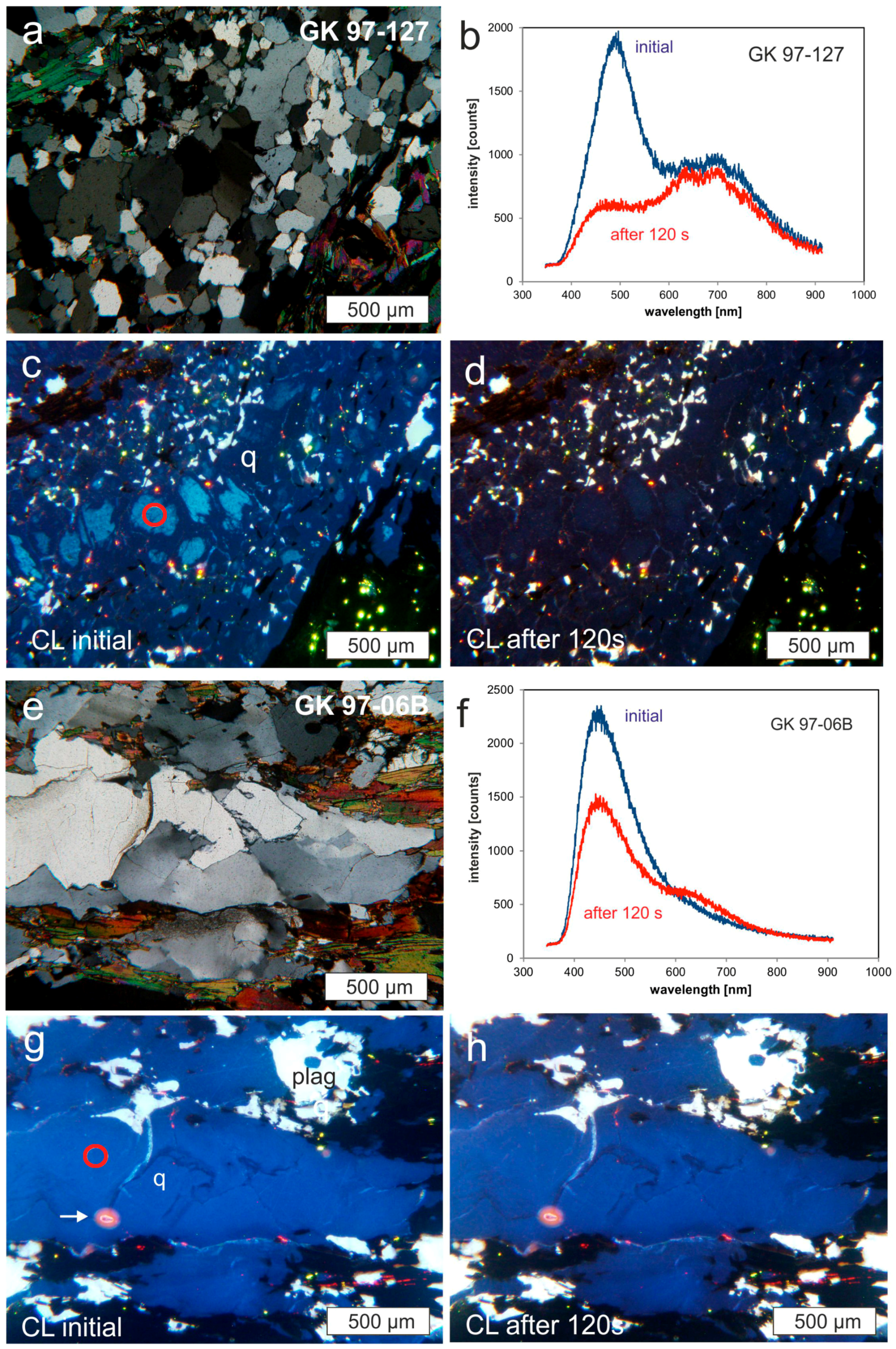
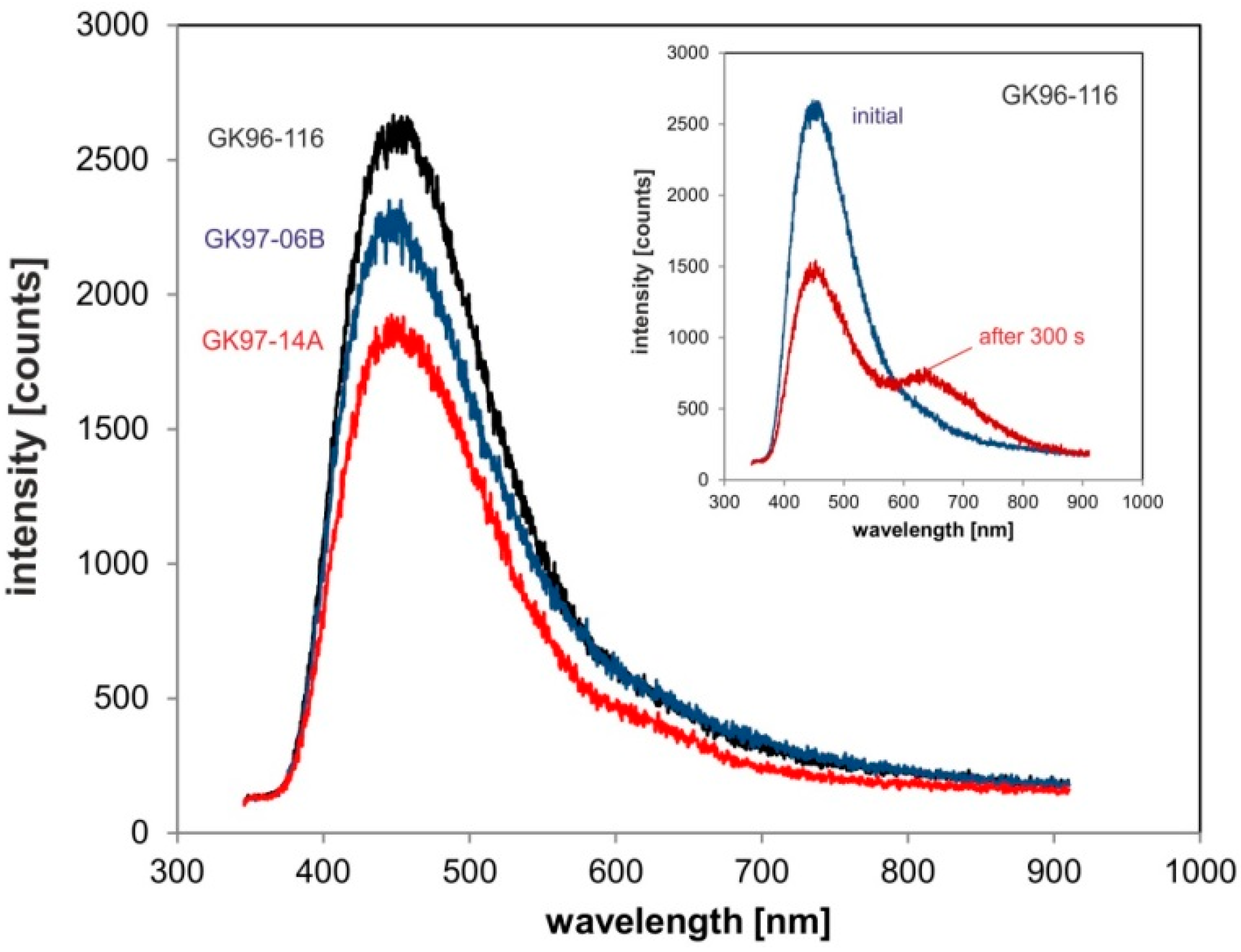

| Sample | Metamorphic Zone | Rock Type | Temperature and Pressure Zone | Coordinates | Tectono-Stratigraphic Zone |
|---|---|---|---|---|---|
| GK 97-124 | Garnet zone | Garnet mica schist | 500 ± 30 °C, 9 ± 1 kbar | 18°55,24 S 13°20,07 E | CKZ |
| GK 96-82 | Garnet zone | Garnet mica schist | 500 ± 30 °C, 9 ± 1 kbar | 18°46,78 S 13°04,78 E | CKZ |
| GK 96-67 | Staurolite zone | Garnet-staurolite mica schist | 580 ± 30 °C, 7–8 kbar | 18°48,17 S 13°07,48 E | CKZ |
| GK 97-47 | Kyanite zone | Kyanite-staurolite mica schist | 590 ± 30 °C, 6.5–8 kbar | 18°48,06 S 13°07,35 E | CKZ |
| GK 97-48 | Kyanite zone | Kyanite-staurolite mica schist | 590 ± 30 °C, 6.5–8 kbar | 18°48,06 S 13°07,35 E | CKZ |
| GK 97-127 | Ky-sill-mu zone | Kyanite-sillimanite mica schist | 650 ± 20 °C, 9 ± 1.5 kbar | 18°47,88 S 13°04,94 E | CKZ |
| GK 97-06B | Grt-crd-sil-Kfs zone | Gneiss with garnet, cordierite and sillimanite | 750 ± 30 °C, 4.0–5.5 kbar | 18°52,76 S 12°51,14 E | WKZ |
| GK 97-14 | Grt-crd-sil-Kfs zone | Migmatitic gneiss with garnet, cordierite and sillimanite | 750 ± 30 °C, 4.0–5.5 kbar | 18°52,76 S 12°51,14 E | WKZ |
| GK 96-116 | Grt-crd-sil-Kfs zone | Migmatitic gneiss with garnet, cordierite and sillimanite | 750 ± 30 °C, 4.0–5.5 kbar | 18°52,77 S 12°50,63 E | WKZ |
| GK 96-110 | Grt-crd-sil-Kfs zone | Garnet-sillimanite gneiss | 750 ± 30 °C, 4.0–5.5 kbar | 18°49,07 S 12°54,75 E | WKZ |
| Group/Sample | Metamorphic Zone | Temperature Zone | Pressure Zone | Initial CL Color | Initial CL Bands |
|---|---|---|---|---|---|
| Group 1 | Grt-crd-sil-Kfs | 750 ± 30 °C | 4.0–5.5 kbar | Intense blue | 450 nm |
| Group 2 | Grt, St, Ky, Ky-sil-ms | 500 ± 30 to 650 ± 20 °C | 9 ± 1.5 kbar | Short-lived Blue-green | 450 nm, 500 nm, 650 nm |
| GK 97-124 | Grt | 500 ± 30 °C | 9 ± 1 kbar | Weak blue | 450 nm, 650 nm |
© 2018 by the authors. Licensee MDPI, Basel, Switzerland. This article is an open access article distributed under the terms and conditions of the Creative Commons Attribution (CC BY) license (http://creativecommons.org/licenses/by/4.0/).
Share and Cite
Sittner, J.; Götze, J. Cathodoluminescence (CL) Characteristics of Quartz from Different Metamorphic Rocks within the Kaoko Belt (Namibia). Minerals 2018, 8, 190. https://doi.org/10.3390/min8050190
Sittner J, Götze J. Cathodoluminescence (CL) Characteristics of Quartz from Different Metamorphic Rocks within the Kaoko Belt (Namibia). Minerals. 2018; 8(5):190. https://doi.org/10.3390/min8050190
Chicago/Turabian StyleSittner, Jonathan, and Jens Götze. 2018. "Cathodoluminescence (CL) Characteristics of Quartz from Different Metamorphic Rocks within the Kaoko Belt (Namibia)" Minerals 8, no. 5: 190. https://doi.org/10.3390/min8050190




